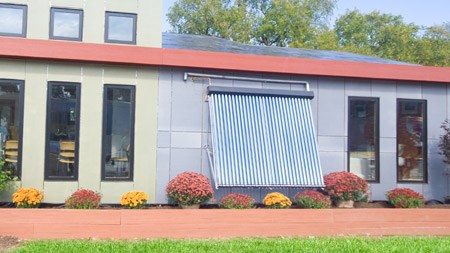Green buildings can now be built for a little more than traditional buildings. For the environmental and economic benefits, it deserves serious consideration.
It has long been held that building ‘green’ is a costly affair. The recently released first edition of ‘Green Building in South Africa: Guide to Costs and Trends’ definitively puts this theory to rest.
According to the report which was collectively compiled by the Green Building Council of South Africa (GBCSA), the Association of South African Quantity Surveyors (ASAQS) and the University of Pretoria (UP), green building costs for GBCSA certified office buildings vary between 1.1% and 14.2% or only 5% more on average than it does to build traditional buildings.
This is far less than what was originally thought. Manfred Braune, GBCSA chief technical offer is quoted as saying that it was previously widely believed that green buildings cost between 20% and 50% more than conventional buildings to build. Braune adds that the findings of the study prove that green buildings can be built for a negligible premium which is steadily declining. The report also indicates that SA’s green industry is maturing and has the potential to be a leader in the global green market within the next few years.
Over the years the GBCSA has certified numerous buildings across South Africa. The buildings are rated according to the Green Star South Africa rating system which is based on the Australian system and customised for the South African context. By adhering to this system, the GBCSA can objectively assess just how green a building really is.
In order to be certified, building owners must submit documentation to the GBCSA. Independent assessors then evaluate the submission and allocate points based on the green measures implemented. Certification is awarded for 4 star, 5 star or 6 star Green Star SA ratings. Each Green Star SA rating tool reflects a different market sector including office, retail, multi-unit residential, public and education buildings as well as others that are in development such as interiors and existing buildings performance.
Through the system, the GBCSA hopes to achieve five clear objectives:
• Establish a common language and standard of measurement for green buildings
• Promote integrated, whole building design
• Raise awareness of the benefits of green building
• Recognise environmental leadership
• Reduce the environmental impact of development
The following three buildings form part of a small but growing group of 6 star rated buildings in South Africa:
Collingwood Building, Black River Park, Cape Town (Existing Building Performance Pilot)
The Collingwood Building was one of the first buildings to be renovated at Black River Park in 2000. The building originally comprised three structures which were joined to create a selection of 80 office spaces and a restaurant. Notable sustainable building features include, amongst others, a 1.2 megawatt photovoltaic solar plant, the first renewable energy project to feed back into the grid, performance glass, on site waste sorting and recycling and ‘green leases’ with 76% of tenants.
Department of Environmental Affairs, Pretoria (Office V1 Design Rating)
This is the first government building in SA to achieve a 6 star Green Star SA rating and the first 6 star rated building in the city of Tshwane. The building also achieved the highest score for a large commercial office space of this magnitude awarded by the GBCSA to date. Sustainable building features include, amongst others, a roof covered almost entirely with solar photovoltaic panels which supply approximately 20% of the building’s energy needs, water efficiency measures, water-wise indigenous plants and efficient irrigation systems.
WWF-SA: Braamfontein (Office Design V1)
A “modest” refurbished building, the WWF building occupies a small, 248sqm site and features a roof garden. The building stands as a “physical representation of the organisation’s values and attitude to environmental responsibility and conservation of natural resources.” Sustainable building features include, amongst others, on site treatment of black water for reuse in the building to flush toilets, sustainable building materials, on site storm water attenuation and rain water harvesting to supplement non-potable water.



